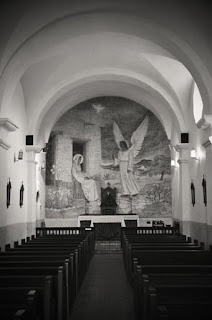 |
| Fayetteville Confederate Cemetery |
The men's original burial places were where they fell when after the battle, soldiers of the victorious side or civilians from the area hurriedly interred the bodies in shallow, makeshift graves trying to prevent disease and the stench of decay. In 1878, the Southern Memorial Association of Washington County established the cemetery and began the process of exhuming the bodies from the area. The Confederates were buried here and the fallen Union soldiers were interred in the Fayetteville National Cemetery.
There are a number of homes just down the hill from the cemetery and the residents often report seeing unusual lights floating along the ridge. There are also numerous reports by residents and visitors alike of strange anomalies showing up in photographs taken within the cemetery. Even more famous though, is the legend of the Burning Bride of Ghost Hollow.
Directly across the slender dirt road from the Confederate cemetery is a much smaller cemetery, The Walker Cemetery is a family burial plot of land much smaller than its neighbor. Here lies the body of David Walker. In the 1860s, he was an Arkansas state senator, three times a state supreme court justice, one of the founders of the University of Arkansas, and served as a colonel in the Confederate army during the war. He was married to Jane Lewis Washington, a third-cousin of George Washington. Buried here next to him are his parents and a few of his close relatives.
In 1872, Judge Walker had a large, 2-story brick house built for his daughter and her husband as a wedding present. It still stands just a little ways away from the family cemetery. Soon after the happy couple moved in though, strange things began to happen. Mostly small things, items disappearing then reappearing several days later, unexplained "moaning" noises, doors slamming closed for no reason. Then the couple became aware they could no longer find hired help. When the last housemaid quit, they inquired to learn why nobody would work for them. They learned the African-American community considered the home haunted because of a horrible accident that happened there years before.
Shortly after the Civil War ended in 1865, a man and his fiancé moved to Fayetteville from Fort Smith trying to start a new life after his hard service in the Confederate army. They constructed a small home on the exact same spot of land as the Walker-built house. They were married in the house one cold winter evening and after the guests left, the bride of one hour, still wearing her wedding dress, leaned over the fireplace to stir the fire. A spark popped onto her dress and set it ablaze. Running and screaming hysterically out of the house, she ran down the ridge and, having ran through the grounds which would later become the Walker and Confederate cemeteries, she fell down and died in agony. From that day on, there have been reports of people seeing her apparition running through both cemeteries and hearing her screams as she over and over, relives her tragic wedding night.
Unfortunately, more tragedy plagued Ghost Mountain. In 1932, a family lived in a small log cabin located near the cemeteries. One night, the husband came home very drunk to his wife who was caring for a sick infant. The baby cried incessantly no matter what the mother tried and the husband, incensed that he couldn't sleep because of it, suddenly grabbed the baby, stumbled outside and threw the baby down the water well. The wife went into hysterics, grabbed the well rope and jumped into the well to save the child. The drunken father picked up a nearby ax and chopped the rope, leaving his wife and child in the well to die. It was several days later when his employer came to investigate why he had not been to work. Seeing the dangling, chopped well rope, he looked down and saw in the dim light, the floating bodies. It is assumed the husband fled the area as he has never been found.
Some say the stories are just myths, there's nothing strange about East Mountain. Others insist the stories are not myths. One thing that is for certain, to this day, the stories remain a source of fear for those living on and around Ghost Mountain.












